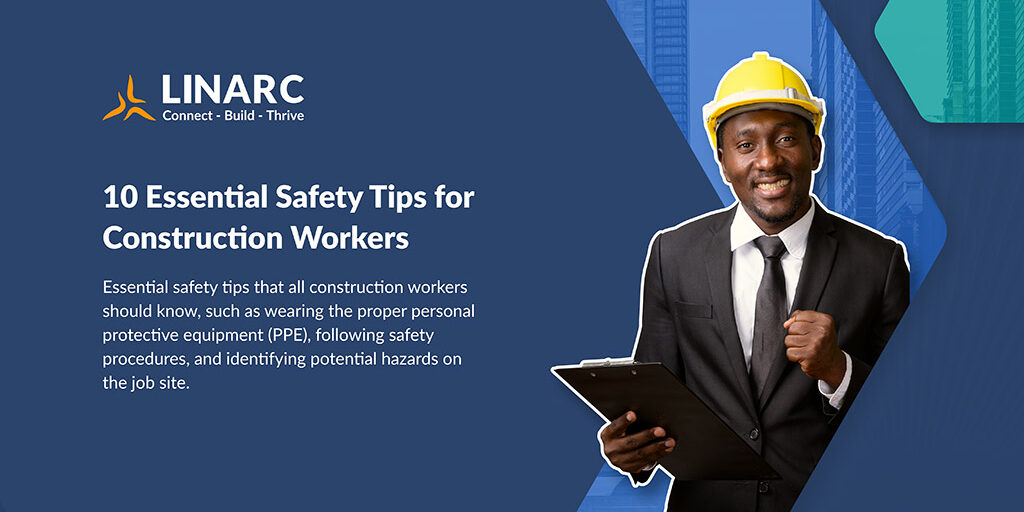10 Essential Safety Tips for Construction Workers

The Importance of Safety for Construction Workers
Safety Tips and Strategies
Construction site safety can be jeopardized in many ways. It is not a one person job, it’s the duty of everyone on the jobsite. Each construction worker from the general contractor to the electrician should be accountable and take personal responsibility for ensuring their work area and performance is safe while following proper procedures and best practices.
To help maintain a safe work environment, here are 10 essential construction safety tips to follow:
1. Don’t Skimp on Personal Protective Equipment (PPE).
Using the right tool for the job is an age-old saying. Consider PPE as a critical tool for the job of being safe. It’s important to select the correct head-to-toe protection for the situation, such as hard hats, safety glasses or goggles, ear plugs, face shields, respirators, long sleeves and pants, gloves, and steel-toed boots or shoes.
Properly fitting PPE is essential for optimal protection, and it’s worth noting that PPE is now available in a range of sizes, including options specifically designed and manufactured for women.
2. Tidy Up.
A clean jobsite leads to a safe job site. On a micro level, workspaces with scattered debris, extension cords, and tools impose trip and fall hazards. At a macro level, a disorganized construction site reduces worker morale, increases accidents, adds risk for OSHA fines and can build a poor reputation for the general contractor.
Construction site safety significantly increases when it is kept clean and organized.
Additionally, a clean site promotes a culture of safety, where workers are encouraged to take responsibility for their own safety and that of their colleagues.
3. Keep Moving.
It’s human nature to stop and watch something of interest. Stay safe on construction sites by keeping moving and staying alert. Remember to keep a safe distance from moving equipment, avoid unnecessary gathering, and watch out for flying debris. Keep the job site clear for other workers to perform their job safely. Take responsibility for your own safety and help create a safer work environment for everyone.
4. Handle Tools with Care.
Proper tool handling is crucial for preventing accidents and injuries on jobsites. According to OSHA, nearly 10% of all construction industry fatalities are due to improper use of tools. When working at an active construction zone, make sure you are following these protocols.
- Inspect your tools carefully before use.
- Make sure that all guards and safety mechanisms are in place and working correctly.
- When carrying a tool with a cord, be sure to hold it by the handle rather than the cord. This will help prevent damage to the cord and reduce the risk of electrical shock
- Maintain a safe posture and grip, and follow recommended cutting or drilling techniques.
5. Find Stability.
Ladders are commonly used in many workplaces, but it’s important to remember that they can be dangerous if not used correctly. One common mistake is taking shortcuts, which can lead to accidents.
To use a ladder safely, it should be set up at a 4:1 ratio – that means for every four feet in height, the base of the ladder should be one foot away from a wall or structure. It’s also crucial to ensure the ladder is placed on a level surface free of slippery conditions.
6. Know the Ins and Outs of a Trench.
Whether in a literal or figurative sense, having a safe means of entry and exit from an excavation or trench site is crucial. It’s also essential to be aware of the plan and layout for heavy equipment paths or soil piles to prevent severe injuries or even fatalities.
Being mindful of environmental hazards such as rain, wind, or standing water is equally important. Additionally, it’s critical to determine if there is adequate cave-in protection on the site.
7. Use Good Posture.
To protect your body, it’s important to practice good posture techniques. When lifting heavy materials, bend your knees and keep your back straight to distribute the weight evenly.
When reading plans, digitally such as with Linarc or the archaic printed project plans, use a document holder or stand to keep the document at eye level and avoid bending your neck. Avoid slouching or leaning forward for long periods, and take breaks to stretch and move around if you have to sit or stand for extended periods.
8. See Something. Say Something.
Promote a culture of safety on the jobsite by identifying and reporting hazards promptly, reminding crew members of safe practices, and taking responsibility for promoting safety. Don’t assume someone else is seeing or handling a safety issue. Each person on the jobsite has a responsibility to ensure a safe work environment.
9. Attend Training.
Regular safety training is crucial to ensuring that construction workers develop safe habits and avoid bad practices. It takes about two months for a new behavior to become automatic or a habit to form. Therefore, frequent training sessions and casual safety reminders can help reinforce safety measures and prevent accidents.
For example, toolbox talks, daily safety briefings, and weekly safety meetings can provide workers with regular safety reminders and opportunities to discuss safety concerns. Continuous training and communication are essential components of effective construction safety management. Using a digital-first approach to real-time project communications can greatly improve safety.
10. Rest and Recharge.
Ensure the safety of all construction workers. Fatigued workers pose a significant danger to construction sites. Taking regular breaks to rest, hydrate, eat, and get enough sleep can help re-energize workers and improve their focus and performance.
Employers should avoid overworking their employees and provide a safe and healthy work environment that allows workers to take sufficient breaks and recharge adequately.
Take care of yourself and others on the jobsite with these 10 essential construction safety tips. Don’t become a statistic. Following safety policies and procedures, speaking up and staying alert on the jobsite will reduce the risk for workplace illnesses, injury or death.




